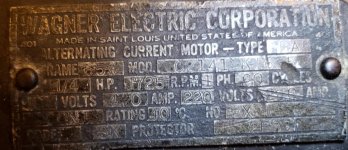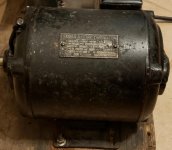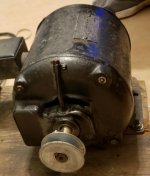I have currently dug my fathers 70 year old band saw out the old shed. Im trying to give it a complete restoration. I remember using this thing all the way back to my early youth. It needs some TLC but i beleive it will turn out very nice.
The motor used to run the band saw is an old Wagner AC 110/220 1 phase (induction?) motor. It has four large brushes inside that engage at startup and release after it spins up. This is the most i have been able to find out about this thing. I cannot find any information online about this motor.
If anyone out there can share some knowledge with me on a couple things i would greatly appreciate it.
A few questions.
How would i go about changing the Bushings/Sleeves? not sure what to call them, it's definitely not bearings. Looks to be a bronze sleeve with an oil channel and oil sponge cutout on the top of the sleeve. And if i can change them, where would i find replacements? i can't even find anything when i try to look up the model number or motor
There is a pulsing when the motor is up to speed and sounds a little rough, although seems to have plenty of life and spins right up, just rough while spinning. Im assuming this is due to worn out bushings. Also the shaft has about 3/4 play in and out in regards to the housing of the motor. I can push it in and out towards the housing of the motor. I also contribute this to worn out bushings/sleeves but i do not know?
Can the speed of this motor be controlled with a controller? I thought i read somewhere when i was trying to find info about this motor, that if it's an ac motor with brushes you can safely control the speed the of the motor with a controller as long as you don't run it too looowwww.
On one side of the motor inside the bell, there is a couple wires attached from the central housing to a little setup with contacts. Anyone know what this is? I ask because when taking it apart to clean it, i accidentally broke the head off the allen screw thinking it was the one holding it to the inside of the outer bell housing. (turns out it was the other screw that held it to the housing.) although the head of the allen screw crumbled away with the slightest pressure, whatever it's holding together has'nt moved or caused any problems yet so im ignoring it for now.
I really want to get this motor running smooth again, electrically it seems very sound. Its just balance or bushings that causing all the rough running now.
I welcome any and all info anyone can provide me with. I know absolutely nothing about this motor, and cannot find any info on it. I would really like to change these bushings/sleeves or perhaps there's a way to shim or smooth them? I have taken armetures out of small airsoft motors and balanced them, i assume it might be the same for a big motor right?
Thanks in advance for anyone willing to stop and share some info.
Wagner Electric Corporation
Alternating Current Motor
TYPE: RA
FRAME: 65X
MOD: C2141 K1635
HP: 1/4
RPM: 1725
PH: 1
CYCLES: 60
110 VOLTS 4 AMP
220 VOLTS 2 AMP
RATING: CONT
C: 40
NO: 3X
Code: SK
Protector: 2P33
All the info i could decipher from the plate
The motor used to run the band saw is an old Wagner AC 110/220 1 phase (induction?) motor. It has four large brushes inside that engage at startup and release after it spins up. This is the most i have been able to find out about this thing. I cannot find any information online about this motor.
If anyone out there can share some knowledge with me on a couple things i would greatly appreciate it.
A few questions.
How would i go about changing the Bushings/Sleeves? not sure what to call them, it's definitely not bearings. Looks to be a bronze sleeve with an oil channel and oil sponge cutout on the top of the sleeve. And if i can change them, where would i find replacements? i can't even find anything when i try to look up the model number or motor
There is a pulsing when the motor is up to speed and sounds a little rough, although seems to have plenty of life and spins right up, just rough while spinning. Im assuming this is due to worn out bushings. Also the shaft has about 3/4 play in and out in regards to the housing of the motor. I can push it in and out towards the housing of the motor. I also contribute this to worn out bushings/sleeves but i do not know?
Can the speed of this motor be controlled with a controller? I thought i read somewhere when i was trying to find info about this motor, that if it's an ac motor with brushes you can safely control the speed the of the motor with a controller as long as you don't run it too looowwww.
On one side of the motor inside the bell, there is a couple wires attached from the central housing to a little setup with contacts. Anyone know what this is? I ask because when taking it apart to clean it, i accidentally broke the head off the allen screw thinking it was the one holding it to the inside of the outer bell housing. (turns out it was the other screw that held it to the housing.) although the head of the allen screw crumbled away with the slightest pressure, whatever it's holding together has'nt moved or caused any problems yet so im ignoring it for now.
I really want to get this motor running smooth again, electrically it seems very sound. Its just balance or bushings that causing all the rough running now.
I welcome any and all info anyone can provide me with. I know absolutely nothing about this motor, and cannot find any info on it. I would really like to change these bushings/sleeves or perhaps there's a way to shim or smooth them? I have taken armetures out of small airsoft motors and balanced them, i assume it might be the same for a big motor right?
Thanks in advance for anyone willing to stop and share some info.
Wagner Electric Corporation
Alternating Current Motor
TYPE: RA
FRAME: 65X
MOD: C2141 K1635
HP: 1/4
RPM: 1725
PH: 1
CYCLES: 60
110 VOLTS 4 AMP
220 VOLTS 2 AMP
RATING: CONT
C: 40
NO: 3X
Code: SK
Protector: 2P33
All the info i could decipher from the plate






